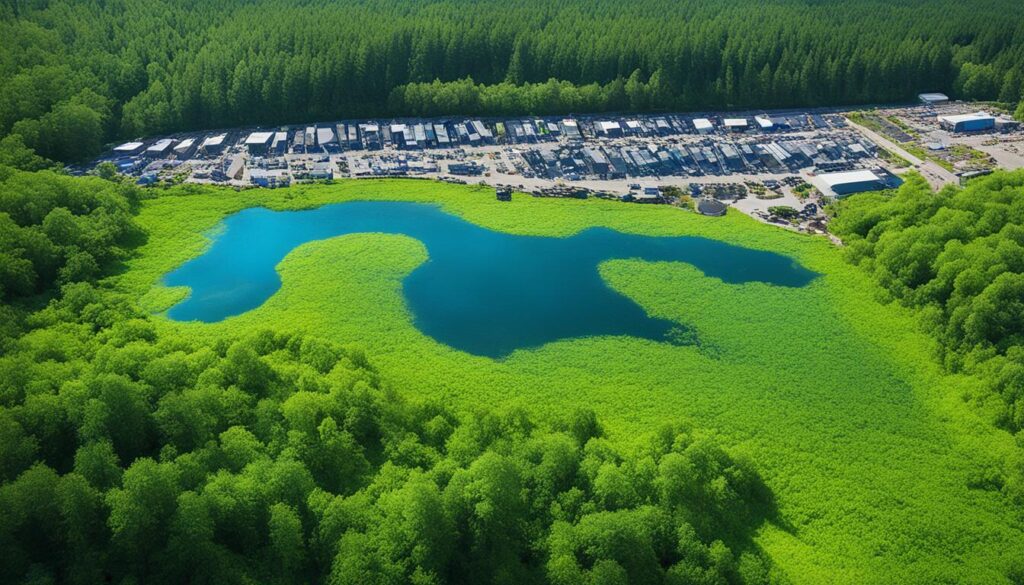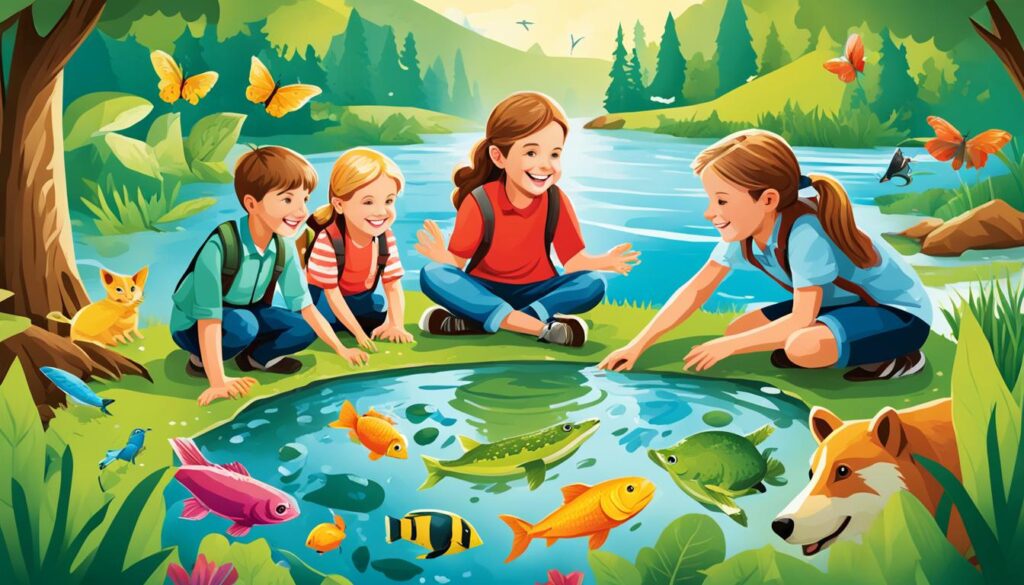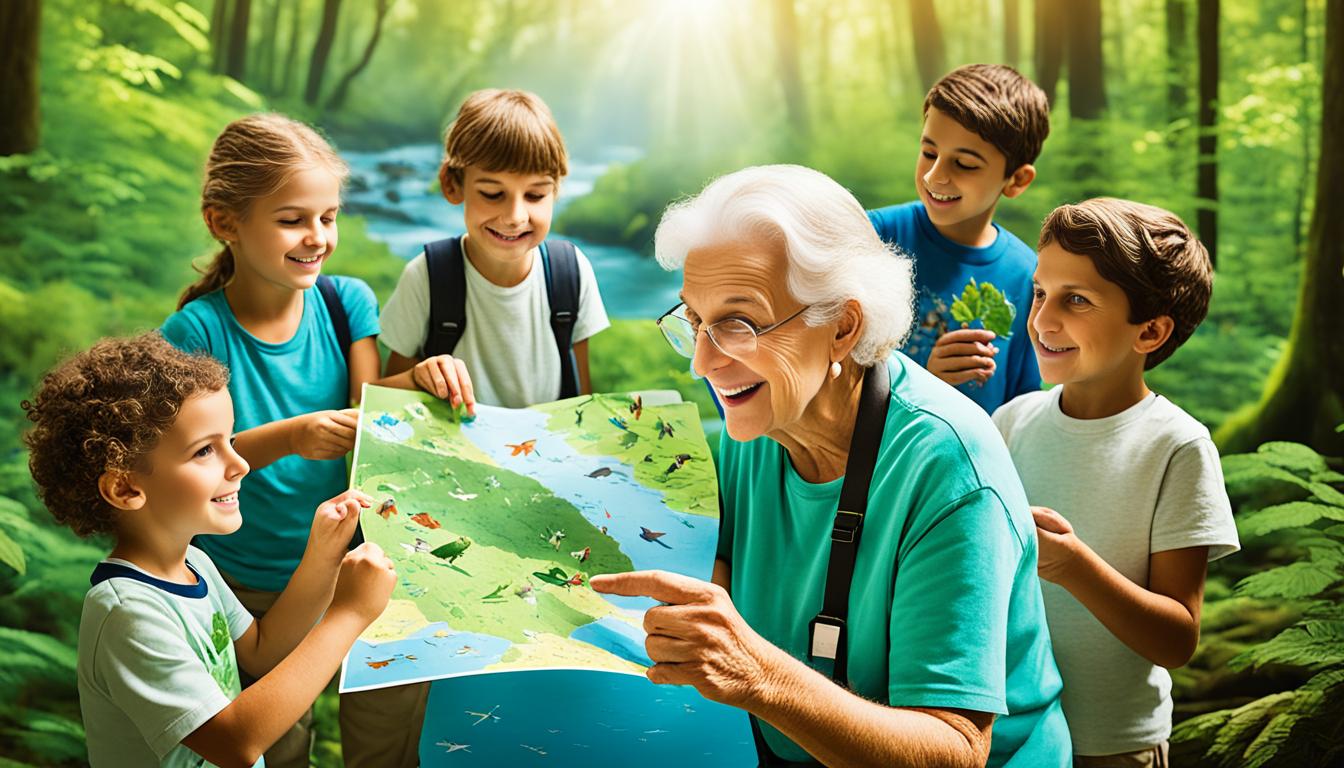In today’s world, teaching about sustainability is crucial. It helps build a future that’s both sustainable and resilient. This type of education gives people the knowledge and skills they need. It shows how everything in nature is connected1.
Studies show that kids start shaping their values very early1. So, we need to make learning about the environment fun and interactive for them1. Kids naturally love the outdoors, a trait called biophilia, which shows up by age two1. That’s why teaching about nature should fit each age group to grow their love and care for the earth1.
Parents and teachers must show how much they enjoy and respect nature. This teaches kids to do the same. When kids get to play outside a lot, they learn to care for the environment better as they grow1. As they move through different stages of growing up, their understanding of and care for the environment gets deeper1.
Key Takeaways
- Sustainability education aims to inspire and empower people to make informed choices and take meaningful action towards a more sustainable world.
- Children form their values in their earliest years, and environmental education should align with their developmental stages.
- Immersive and hands-on learning environments, as well as regular contact with nature, are crucial for effective environmental education.
- Adults play a crucial role in modeling enjoyment, comfort, and respect for nature to instill pro-environmental values in children.
- Environmental education can foster empathy, positive environmental behaviors, and a lifelong commitment to sustainability.
Understanding Sustainability Education
Sustainability education covers many topics like environmental science, economics, and ethics2. It looks at how our actions affect nature. This helps students think about their choices more deeply2.
Interdisciplinary Approach
It mixes different fields like science and language arts to show why caring for our planet matters2. Through these connections, students learn the big picture of our environmental challenges2.
Fostering Holistic Thinking
This kind of education is about more than learning facts. It teaches us to view the world in a whole new way2. We see how everything is connected and understand the impact of our decisions better2.
“Sustainability education is not just about teaching environmental science; it’s about cultivating a mindset that recognizes the complex relationships between humans and the natural world. It’s a transformative process that empowers individuals to become agents of positive change.” – Dr. Emily Greenfield, Environmental Education Researcher3
This education helps students tackle environmental problems. It teaches them to think broadly and act responsibly2. With these skills, they can help build a greener future2.
Key Components of Sustainability Education
Sustainability education is about looking at the big picture. It helps people understand the world as a whole and how we affect it. Systems thinking, environmental literacy, and critical thinking and problem-solving are the three main elements. They give us the tools to move towards a better, sustainable future.
Systems Thinking
This type of learning shows us that everything is connected. What we do in one part of the world can impact another part4.. This knowledge is key in understanding our connections to the environment and the major issues the Earth faces.
Environmental Literacy
Environmental literacy means we grasp the basics of nature and how we manage its resources. We learn how our actions can harm the world4. Armed with this knowledge, it’s easier to make choices that are good for our planet.
Critical Thinking and Problem-Solving
Sustainability learning sharpens our ability to think critically. It urges us to question things and come up with new, smart ideas to solve big problems4. With this approach, we can truly make a difference by finding better ways to live and support our communities and world.
| Key Component | Description |
|---|---|
| Systems Thinking | Recognizing the interconnectedness of human activities, ecosystems, and global challenges |
| Environmental Literacy | Understanding the principles of ecology, natural resource management, and the impact of human activities on the environment |
| Critical Thinking and Problem-Solving | Analyzing complex issues, questioning assumptions, and developing innovative solutions to tackle sustainability challenges |
“Effective sustainability education moves beyond engagement to empowerment, enabling students to take local action and contribute to community well-being.”4
Sustainability education makes us ready for change. It gives us the knowledge and tools to face current social and environmental issues456.
Benefits of Sustainability Education
Sustainability education helps people understand and tackle big environmental issues7. It inspires action, making people want to make things better. This can be done through small personal steps, local group efforts, or even influencing bigger policies7. It also shows how everything in our world is connected. This prepares us to deal with changes, making us stronger in the face of future challenges7.
Empowerment and Engagement
This type of learning makes students want to learn more7. Schools focused on the environment have shown that students not only learn better but also enjoy learning7. When students work on local environmental issues, they get better at problem-solving. They also become more confident in finding solutions, which improves their science skills7. Using technology in these lessons also helps students become more tech-savvy7.
Resilience and Adaptability
Sustainability education is all about teaching skills that we need today. These include thinking critically, solving problems, and being creative8. When students work together on real-life environmental projects, their creativity grows. They learn to find innovative solutions to tough problems7. Connecting these lessons to science, technology, engineering, and math (STEM) also sparks creativity. It builds important skills and raises awareness of social and environmental issues7.
Through environmental education, students become more proactive about saving our planet7. They become better at making positive changes around them, boosting environmental health7. This drive and knowledge they gain are key to solving global issues in lasting ways8.
“Environmental education is a powerful tool for instilling passion for learning, developing personal growth and life-building skills, and enhancing knowledge.”8
Promoting Sustainable Development
Sustainability education is key to hitting sustainable goals. It helps people change to greener habits and lives. This means they help save natural resources, cut back on waste, and make our communities fair for all9.
The 1992 Rio Summit led to Agenda 21. This plan aims for development that doesn’t hurt our planet’s future. It depends on everyone getting involved in looking after our environment and solving social and economic problems worldwide9.
Finding a balance between economy, people, and nature is crucial. We should meet today’s needs without stopping future gens from meeting theirs9. Learning about the environment makes a big difference in farming, women’s rights, and how we live9.
Agenda 21 also highlights the importance of including young people. It wants them to join in making education and the environment better. Through education, people can learn to care and make smart choices for our planet9.
Teaching the environment helps a lot with thinking about how we can develop well. The success of these lessons can change depending on where you live and what you need9.
Linking a clean environment, fair life for all, and human rights makes education about the earth more powerful9. Sadly, lack of money and skilled workers in poor parts of the world holds back our global efforts. Plus, moving polluting factories makes things worse, even though we talk a lot about saving the earth in big meetings10.
One big problem is we don’t all agree on what sustainable development is10. True improvement needs people to care more for nature and our environment. Just using science and tech is not enough to save our world10.
Teaching people to respect the environment is very important. This includes future professionals, like engineers, so they can help in smart ways on how we build and live for a better future10.

A study in Ireland showed we still need more people to get involved in eco-teaching. While many in the green field took part, we need more from different areas to join in11. Together, they offer various programs in schools and beyond to teach about saving our planet11.
We looked to get feedback from different teaching groups, including NGOs and business groups11. It showed that in places where green lessons were strong, they had more and better projects teaching about how to develop in a good way11.
There are lots of ways to teach about saving our world. This study found many good projects in education for nature saving. But some groups didn’t respond much, like businesses or media, possibly because they’re very busy11.
The best lessons in saving our planet should focus on how we learn and think. They should be smart, make a real difference, and show we can do these good actions again and again. They should also check if they’re working well and helping the planet11.
“Sustainable development is development that meets the needs of the present without compromising the ability of future generations to meet their own needs.”
– Brundtland Commission
Nurturing Global Citizenship
Sustainability education teaches people to care for our planet. This means looking beyond just where we live. It shows us that we are global citizens, and we all have a part to play12. We must work together to solve big problems facing the world, such as climate change12.
Cross-Cultural Understanding
Learning about sustainability helps us connect with the world. It teaches us to make things fairer for everyone and to be careful with the earth12. Understanding different cultures is a big part of this. It helps us see the value in all people and work together across the globe13.
Collective Action
We learn how to work as a team in sustainability education. We learn to help with big worldwide problems like climate change or poverty12. This way, everyone does their part to make the world a better place12.
Places like Ana G. Mendez University, UNICEF, and Oxfam are leading in teaching about global citizenship. They show that this kind of education can make our world better for everyone, as UNESCO points out12.
“Global citizenship education provides understanding, skills, and values needed to cooperate in resolving global challenges like climate change, conflict, poverty, and hunger.”
In our connected world, teaching about global citizenship is very important. By understanding others and working together, we can create a fairer and greener future for everyone121314.
Integrating Environmental Education
Teaching about the environment is key for a better future. When we include it in schools and community activities, we help people of all ages understand and care for our world. This leads to better ways of living for everyone.
Formal Learning Settings
In schools, we can easily teach about the environment15. For instance, in the Philippines, the education system is making sure that teachers learn how to talk about nature in lessons. Even subjects like Physical Education and General Education are being used to teach students more about their environment.
Over in the United States, places like James Madison University are teaching environment science in a unique way16. Their program has attracted many students. Most of them decide to learn about the environment and another subject together. This way, students understand not just the environment but also how it’s linked to other parts of life.
Informal Learning Opportunities
Yet, learning about the environment isn’t only in schools. It can happen in the community, too15. Many teachers go out and share their knowledge with people outside school. They use events, online talks, and social media to talk about taking care of our planet. This gets everyone, old and young, interested in doing their part for the environment.
The National Science Teachers Association, or NSTA, loves the idea of teaching kids of all ages about the environment17. They say it’s important to use cool, hands-on ways of teaching to get students thinking. They also want different groups to work together so that students can learn different things and find jobs in protecting our planet17.

Both in schools and outside, teaching about the environment helps us all learn how to live better. This way, from young kids to older adults, everyone can learn the skills they need to take care of Earth151617.
Environmental Education: A Comprehensive Approach
Sustainability education is all about connecting the dots. It shows how environmental, social, and economic issues are linked. This approach helps us make educational programs that really make a difference. It empowers people to spark change for a better future18.
True environmental education goes way beyond just sharing facts. It also builds values, skills, and a desire to get involved. This way, people become active stewards of the Earth. They learn to think critically and help manage our environment wisely18.
Wisconsin is a big player in this initiative. It honors schools and other groups that cut their environmental impact, boost health, and grow their environmental smarts19.
The ED-GRS looks for schools that teach across subjects, teach STEM well, and get students involved in the community. Applicants must show they are meeting key program goals. This includes lowering emissions, improving water, and having strong environment-focused health programs19.
Environment education isn’t just for classrooms. It also happens outside, where people can work with their communities and nature directly. By spreading environment learning everywhere, we make it a key part of how we learn and live. This broadens the impact of sustainability education18.
A big, wide-reaching strategy is key to environmental education. It helps create knowledgeable, active people who care about the Earth. This approach encourages people to tackle big environmental issues with a mix of different skills. It’s how we turn to a more sustainable future18.
| Key Components of Comprehensive Environmental Education | Benefits |
|---|---|
|
|
“Environmental education is an approach, tool, and profession aimed at creating an environmentally literate citizenry.”20
Adopting a comprehensive perspective on environmental education is crucial. It spurs the remarkable impact of sustainable development and equips people to safeguard our planet’s wellbeing.
Challenges and Opportunities
The climate change and resource depletion challenges are big, but they push us to think out of the box and work together. Back in 1977, the Tbilisi Definition and in 1987, the Brundtland Report on sustainability21 set the path. These days, environmental education reaches from little kids to the elderly, focusing on hands-on learning and connecting different school subjects21.
It’s all about teaching folks how to solve problems and make good choices21. These lessons deal with big topics like the Next Generation Science Standards, STEM, and learning about climate change21. People who spread these teachings work in schools, companies, groups that protect nature, health fields, colleges, and the media21. They all aim to make everyone care about our planet. This way, we can tackle the tough issues and build a future that’s good for all of us.
But, checking if these teaching programs work well is a bit behind. Fewer than a third of them have been looked into closely. And just a quarter have been assessed after they finished22. There’s not a lot of new research about this, either. Only 30 useful articles were found in the top three journals in the last 15 years22. The North American Association for Environmental Education (NAAEE) is helping improve things by setting quality standards for these programs22. Fixing these issues and using what’s good about environmental education can help us move towards a planet that lasts.
FAQ
What is sustainability education?
What are the key components of sustainability education?
How does sustainability education empower individuals?
What is the role of sustainability education in achieving sustainable development goals?
How can sustainability education foster global citizenship?
How can sustainability education be integrated into different learning settings?
Source Links
- Developmentally Appropriate Environmental Education for Young Children
- Sustainability in Education: A Comprehensive Guide for Teachers
- The Importance of Environmental Education for a Sustainable Future | Earth.Org
- Essential Elements of Sustainability Education « Journal of Sustainability Education
- Environmental and Sustainability Education
- Benefits of Environmental Education
- The Benefits of Environmental Education for K–12 Students | North American Association for Environmental Education
- Introduction
- Untitled Document
- Education and sustainable development | Development Education Review
- Global Citizenship Education | United Nations
- Nurturing Global Citizens with AI-Powered Education – Teachflow.AI
- ERIC – EJ1334770 – Integration of Environmental Education (EE) in Teacher Education Programs: Toward Sustainable Curriculum Greening, Problems of Education in the 21st Century, 2022
- winebrake
- Environmental Education
- A comprehensive approach to effective environmental education
- U.S. Department of Education Green Ribbon Schools and District Sustainability Award
- Early childhood environmental education: A systematic review of the research literature
- About EE and Why It Matters | North American Association for Environmental Education
- Challenges and opportunities for evaluating environmental education programs

